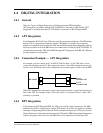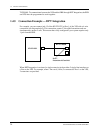
1.3 SYSTEM BASICS
VOICE PROCESSING SYSTEM OVERVIEW
19
Note
When setting the DIP switch to any position (except 0), first disconnect the station wire(s)
and wait a few minutes, then disconnect the AC cord from the VPS. Set the DIP switch
and connect the AC cord to the VPS, wait approximately 3.5 min and then return the DIP
switch to position 0.
Ground Terminal:
This terminal should be connected to a ground source with less than 1 resistance.
EIA (RS-232C) Connector:
Connects an ASCII or VT terminal to the VPS; must be used to program system.
Memory Card:
(1/system) Stores the proprietary system program, and the voice prompts (about 30 min worth);
has the capacity to record approximately 2 h (KX-TVS50) or 6h (KX-TVS80) of messages
from callers.
Optional Expansion Memory Card:
The KX-TVS52 can expand the flash memory capacity of the KX-TVS50 by 2 h.
1.3.3 Which Phone Systems are Compatible?
We recommend integration with the following Panasonic phone systems:
•
Panasonic KX-TD1232
•
Panasonic KX-TD816
•
Panasonic KX-T336
•
Panasonic KX-T123211D, KX-TA624
•
Panasonic KX-TD308
We cannot guarantee adequate integration of the KX-TVS50/80 with other PBX systems or
with Key Systems. If the customer does not have one of the recommended Panasonic PBX
systems, be sure that the system has the features listed below.
The PBX should have the following features for successful integration:
•
Single line (tip/ring) port circuits (Some PBXs need an OPX card to provide this
connection.)
•
Station to station DTMF signaling
•
Message Waiting Notification from an SLT (single-line telephone)
•
Screened transfer from an SLT
•
Message Waiting Notification on proprietary (multi-line) sets (message waiting lamp
accessed by dialing on/off codes)
If the PBX does not have these features, VPS operation will be limited.


















